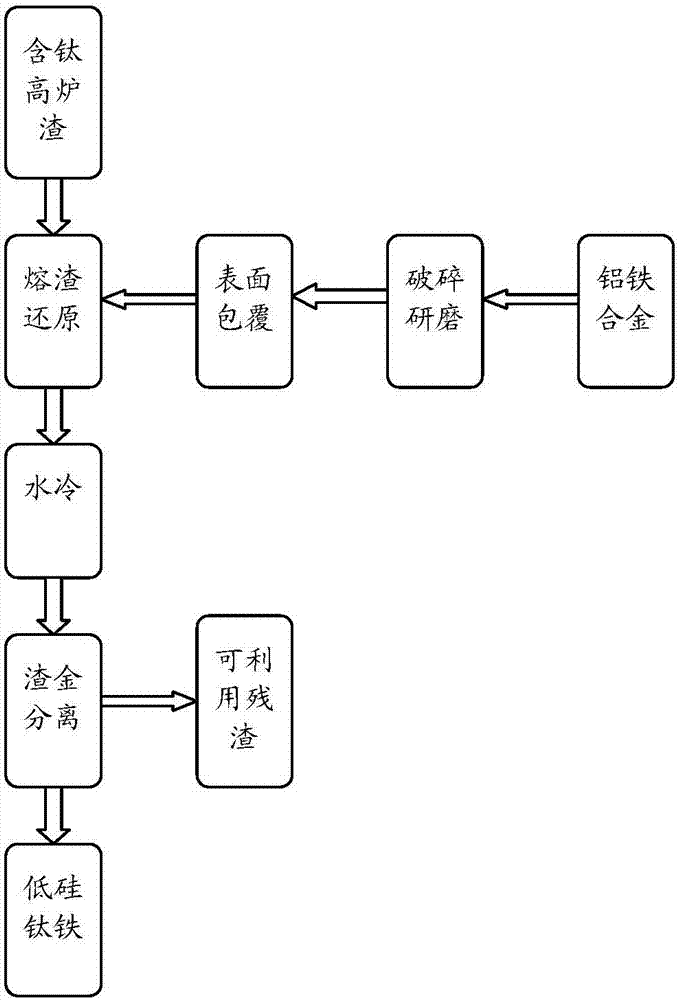Process for smelting low-silicon ferrotitanium by fusing titanium-containing blast furnace slag
A blast furnace slag and silicon-titanium technology, which is applied in the field of utilizing molten titanium-containing blast furnace slag to produce low-silicon ferro-titanium, can solve the problems of high process cost, large amount of residue, and little improvement in reduction efficiency, and achieve stable process parameters and high process efficiency. The process is simple and beneficial to the effect of separation
- Summary
- Abstract
- Description
- Claims
- Application Information
AI Technical Summary
Problems solved by technology
Method used
Image
Examples
Embodiment 1
[0017] 1) Prepare materials according to the mass ratio of slag: aluminum iron: calcium oxide = 100:37.94:10, weigh 200g of titanium-containing blast furnace slag, 75.88g of aluminum-iron alloy, wherein the aluminum content is 50%, calcium oxide 20g, spare, the percentage is the mass percentage;
[0018] 2) Crushing and grinding the aluminum-iron alloy to a size greater than or equal to 300 mesh, adding calcium oxide mixture for 2 hours, so that the calcium oxide is uniformly coated on the powder surface;
[0019] 3) Put the titanium-containing blast furnace slag into the magnesia crucible, coat the crucible with graphite to protect it, put it into the MoSi2 resistance furnace, raise the temperature to 1450°C with the furnace, and change it to automatic constant temperature control. After the slag is melted, the depth of the molten pool is about 55mm. The ingredients mixed in step 2 are evenly added into the molten pool through the rotary feeding device above the crucible. The...
Embodiment 2
[0023] 1) Prepare materials according to the mass ratio of slag: aluminum iron: calcium oxide = 100:37.94:13, weigh 300g of titanium-containing blast furnace slag, 113.82g of aluminum-iron alloy, wherein the aluminum content is 50%, and 39g of calcium oxide, and set aside.
[0024] 2) Crushing and grinding the aluminum-iron alloy to a size greater than or equal to 300 mesh, adding calcium oxide mixture for 2 hours, so that the calcium oxide is uniformly coated on the powder surface;
[0025] 3) Put the titanium-containing blast furnace slag into the magnesia crucible, cover the crucible with graphite to protect it, put it into the MoSi2 resistance furnace, raise the temperature to 1550°C with the furnace, and change it to automatic constant temperature control. After the slag is melted, the depth of the molten pool is about 80mm, and the ingredients mixed in step 2 are evenly added into the molten pool through the rotary feeding device above the crucible, and the feeding speed ...
Embodiment 3
[0029] 1) Prepare materials according to the mass ratio of slag: aluminum iron: calcium oxide = 100:37.94:15, weigh 400g of titanium-containing blast furnace slag, 151.76g of aluminum-iron alloy, wherein the aluminum content is 50%, and 60g of calcium oxide, and set aside.
[0030] 2) Crushing and grinding the aluminum-iron alloy to a size greater than or equal to 300 mesh, adding calcium oxide mixture for 2 hours, so that the calcium oxide is uniformly coated on the powder surface;
[0031]3) Put the titanium-containing blast furnace slag into the magnesia crucible, cover the crucible with graphite to protect it, put it into the MoSi2 resistance furnace, and change the temperature to automatic constant temperature control with the furnace rising to 1600 °C. After the slag is melted, the depth of the molten pool is about 110mm, and the ingredients mixed in step 2 are evenly added into the molten pool through the rotary feeding device above the crucible, and the feeding speed is...
PUM
| Property | Measurement | Unit |
|---|---|---|
| depth | aaaaa | aaaaa |
Abstract
Description
Claims
Application Information
 Login to View More
Login to View More - R&D
- Intellectual Property
- Life Sciences
- Materials
- Tech Scout
- Unparalleled Data Quality
- Higher Quality Content
- 60% Fewer Hallucinations
Browse by: Latest US Patents, China's latest patents, Technical Efficacy Thesaurus, Application Domain, Technology Topic, Popular Technical Reports.
© 2025 PatSnap. All rights reserved.Legal|Privacy policy|Modern Slavery Act Transparency Statement|Sitemap|About US| Contact US: help@patsnap.com


